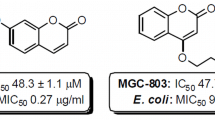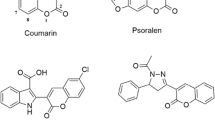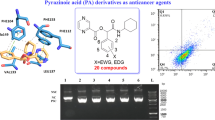Chemistry
Synthesis of 4-hydroxy-3-nitrocoumarin (2)
Commercially available 4-hydroxycoumarin (1, 3.24 g, 20 mmol, Aldrich) was dissolved in AcOH (60 mL). One portion of sodium nitrite (14 mg, 0.2 mmol) was added to this solution before HNO3 (3 mL) dropwise. The reaction was allowed to stir 10 min at room temperature, followed by heating at 60 °C for 1 h in an oil bath. The brown solution was allowed to attain to the room temperature and the pure compound crystallized out from the solution. The suspension was filtered and washed with hexane, and then dried to afford 3-nitro-4-hydroxycoumarin (2) as off-yellow crystals. 3.5 g; yield 85%.
Synthesis of 3-amino-4-hydroxycoumarin (3)
4-Hydroxy-3-nitrocoumarin (2, 3.1 g, 15 mmol) was dissolved in EtOH, and a catalytic amount of Pd/C (30 mg) was added to the mixture at room temperature. The resulting solution was stirred at room temperature under H2 atmosphere for 5 h. After completion of the reaction, the mixture was filtered to remove the catalyst with celite pad, washed with MeOH and ethyl acetate, and concentrated to afford an off-white solid. 2.3 g; yield 87%.
General procedure for the preparation of 3-aminocoumarins (4a–4j)
3-Amino-4-hydroxycoumarin (3, 90 mg, 0.5 mmol) was dissolved in CH2Cl2. Pyridine (120 uL, 1.5 mmol) was then added, and the mixture was cooled to 0 °C. Variously substituted acid chloride (4a–4j) was added dropwise at 0 °C, and the mixture was stirred overnight at room temperature. The reaction mixture was evaporated and purified by column chromatography (Hexane/EtOAc, 9:1) to give the compounds 3-aminocoumarins (4a–4j). The yield of 10 compounds is over 80%. NMR and LC–MS spectra were obtained using a JEOL 400 MHz NMR spectrometer (JEOL, Ltd., Tokyo, Japan) and LC–MS spectrometer (Agilent Technologies, Santa Clara, CA, USA), respectively (Supplementary Fig. S5).
Compd. 4a: 2-ethoxy-N-(4-hydroxy-2-oxo-2H-chromen-3-yl)benzamide. 1H NMR (400 MHz, CDCl3) δ: 11.06 (s, NH), 8.27 (d, J = 7.6 Hz, 1H), 8.04 (d, J = 7.6 Hz, 1H), 7.569–7.50 (m, 2H), 7.35–7.30 (m, 2H), 7.13–7.05 (m, 2H), 4.37–4.32 (m, 2H), 1.72–1.68 (m, 3H). 13C NMR (100 MHz, CDCl3) δ: 165.35, 161.11, 157.80, 153.41, 150.79, 134.73, 132.64, 131.52, 124.54, 121.33, 118.70, 117.56, 116.22, 112.46, 105.57, 65.81, 14.73. LC–MS (ESI+): Calc. for C18H15NO5 [M + H]+: 326.10, Found: 326.2.
Compd. 4b: N-(4-hydroxy-2-oxo-2H-chromen-3-yl)-4-methoxybenzamide. 1H NMR (400 MHz, CDCl3) δ: 8.80 (s, NH), 8.03 (d, J = 6.8 Hz, 1H), 7.94 (d, J = 6.8 Hz, 1H), 7.55–7.53 (t, 2H), 7.38–7.33 (t, 2H), 7.01–6.99 (d, J = 6.8 Hz, 2H), 3.90 (s, 3H). 13C NMR (100 MHz, CDCl3) δ: 166.98, 163.75, 161.41, 152.72, 150.54, 131.71, 129.78, 124.80, 124.52, 123.60, 117.33, 116.34, 114.42, 104.95, 55.70. LC–MS (ESI+): Calc. for C17H14NO5 [M + H]+: 312.09, Found: 312.2.
Compd. 4c: 2-chloro-N-(4-hydroxy-2-oxo-2H-chromen-3-yl)benzamide. 1H NMR (400 MHz, CDCl3) δ: 9.14 (s, NH), 8.05 (d, J = 8.4 Hz, 1H), 7.87 (d, J = 8.4 Hz, 1H), 7.59–7.54 (t, 1H), 7.53–7.47 (m, 2H), 7.44–7.40 (m, 1H), 7.38–7.34 (m, 2H). 13C NMR (100 MHz, CDCl3) δ: 166.57, 162.75, 160.98, 150.75, 133.08, 132.05, 131.91, 131.64, 131.06, 130.94, 127.51, 124.86, 124.62, 117.07, 116.40, 104.91. LC–MS (ESI+): Calc. for C16H11ClNO4 [M + H]+: 316.04, Found: 316.2.
Compd. 4d: N-(4-hydroxy-2-oxo-2H-chromen-3-yl)-2-methylbenzamide. 1H NMR (400 MHz, CDCl3) δ: 8.50 (s, NH), 8.04 (d, J = 8.0 Hz, 1H), 7.62 (d, J = 8.4 Hz, 1H), 7.58–7.56 (t, 1H), 7.490–7.30 (m, 4H), 2.61 (s, 3H). 13C NMR (100 MHz, CDCl3) δ: 170.52, 161.12, 152.87, 150.65, 137.33, 133.00, 131.90, 131.86, 131.82, 127.66, 126.38, 124.86, 124.55, 117.16, 116.37, 105.08, 20.39. LC–MS (ESI+): Calc. for C17H14NO4 [M + H]+: 296.09, Found: 296.2.
Compd. 4e: N-(4-hydroxy-2-oxo-2H-chromen-3-yl)-3-methylbenzamide. 1H NMR (400 MHz, CDCl3) δ: 8.88 (s, NH), 8.04 (d, J = 6.8 Hz, 1H), 7.76–7.74 (m, 2H), 7.58–7.54 (m, 1H), 7.43–7.41 (m, 2H), 7.40–7.341 (m, 2H), 2.45 (s, 3H). 13C NMR (100 MHz, CDCl3) δ: 170.60, 167.76, 161.32, 150.61, 139.24, 134.17, 131.86, 131.52, 129.08, 128.20, 124.87, 124.78, 124.75, 116.37, 110.16, 104.86, 21.47. LC–MS (ESI+): Calc. for C17H14NO4 [M + H]+: 296.09, Found: 296.2.
Compd. 4f.: 4-chloro-N-(4-hydroxy-2-oxo-2H-chromen-3-yl)benzamide. 1H NMR (400 MHz, CDCl3) δ: 8.86 (s, NH), 8.04 (d, J = 6.4 Hz, 1H), 7.92 (d, J = 8.4 Hz, 2H), 7.59–7.55 (t, 1H), 7.53–7.50 (m, 2H), 7.39–7.34 (m, 2H). 13C NMR (100 MHz, CDCl3) δ: 166.40, 161.27, 152.96, 150.72, 141.04, 139.93, 132.03, 129.53, 129.07, 124.93, 124.59, 117.11, 116.42, 104.66. LC–MS (ESI+): Calc. for C16H11ClNO4 [M + H]+: 316.04, Found: 316.2.
Compd. 4g: 4-fluoro-N-(4-hydroxy-2-oxo-2H-chromen-3-yl)benzamide. 1H NMR (400 MHz, CDCl3) δ: 9.66 (s, NH), 8.18–8.14 (t, 1H), 8.04 (d, J = 7.2 Hz, 1H), 7.64–7.60 (t, 1H), 7.58–7.54 (m, 1H), 7.38–7.33 (m, 2H), 7.26–7.23 (m, 2H). 13C NMR (100 MHz, CDCl3) δ: 163.39, 161.00, 153.07, 150.78, 135.35, 135.26, 132.20, 131.93, 125.33, 124.77, 124.59, 117.16, 116.86, 116.62, 116.40, 105.08. LC–MS (ESI+): Calc. for C16H11FNO4 [M + H]+: 300.07, Found: 300.2.
Compd. 4h: 3-chloro-N-(4-hydroxy-2-oxo-2H-chromen-3-yl)benzamide. 1H NMR (400 MHz, CDCl3) δ: 8.87 (s, NH), 8.05 (d, J = 8 Hz, 1H), 7.96 (m, 1H), 7.83 (d, J = 8 Hz, 1H), 7.61–7.55 (m, 2H), 7.50–7.46 (m, 1H), 7.9–7.35 (m, 2H). 13C NMR (100 MHz, CDCl3) δ: 166.15, 161.22, 153.03, 150.65, 135.60, 133.39, 132.08, 130.46, 128.12, 125.49, 124.94, 124.61, 116.43. LC–MS (ESI+): Calc. for C16H11ClNO4 [M + H]+: 316.04, Found: 316.2.
Compd. 4i: N-(4-hydroxy-2-oxo-2H-chromen-3-yl)-[1,1′-biphenyl]-4-carboxamide. 1H NMR (400 MHz, CDCl3) δ: 8.95 (s, NH), 8.05–8.02 (m, 3H), 7.76 (d, J = 8.8 Hz, 2H), 7.65 (d, J = 8.8 Hz, 2H), 7.59–7.54 (m, 1H), 7.50–7.47 (m, 2H), 7.44–7.35 (m, 3H). 13C NMR (100 MHz, CDCl3) δ: 167.19, 161.35, 152.93, 150.61, 146.23, 139.52, 131.88, 130.07, 129.14, 128.58, 128.25, 127.78, 127.38, 124.87, 124.58, 117.24, 116.39, 104.87. LC–MS (ESI+): Calc. for C22H16NO4 [M + H]+: 358.11, Found: 358.2.
Compd. 4j: 2-fluoro-N-(4-hydroxy-2-oxo-2H-chromen-3-yl)benzamide. 1H NMR (400 MHz, CDCl3) δ: 8.05–8.01 (m, 2H), 7.60–7.54 (m, 2H), 7.25–7.14 (m, 4H). 13C NMR (100 MHz, CDCl3) δ: 169.89, 164.01, 161.41, 135.66, 135.57, 132.83, 124.20, 124.16, 117.87, 117.79, 117.35, 117.12. LC–MS (ESI+): Calc. for C16H11FNO4 [M + H]+: 300.07, Found: 300.2.
Biological evaluation
Cell culture and material
The lung cancer cell lines A549, H1650, H1975, and H460 were obtained from the Korean Cell Line Bank (Seoul, South Korea). Cells were cultured in RPMI 1640/DMEM culture medium (Gen Depot, TX, USA) supplemented with 10% fetal bovine serum (Gen Depot, TX, USA) and 1% Penicillin–Streptomycin solution. Cells were cultured in 5% CO2 in a humidified atmosphere at 37 °C. 4-Hydroxycoumarin was purchased from Sigma-Aldrich (H23805).
MTT assay
Cells (2 × 104 cells/well) were seeded on a 96-well plate, grown overnight, and then treated with 4-hydroxycoumarin and its derivatives 4a–4j at concentrations from 3.125 to 100 μM for 48 h. After incubation with MTT at 37 °C, cells were lysed with 150 μL of DMSO (Sigma-Aldrich, St. Louis, USA) and absorbance was measured spectrophotometrically at 540 nm.
Invasion assay
Invasion assays were performed in Transwell chambers (Corning, New York, USA) with 8 μm pore size polycarbonate membrane coated with 1% gelatin. A549, H1650, H1975, and H460 cells were plated at 2 × 106 cells/mL in RPMI1640 containing 0.2% bovine serum albumin (BSA) in the upper compartment of the chamber. The lower chamber was filled with 400 μL RPMI containing 0.2% BSA and 10 μg/mL fibronectin (EMD MilliporeCorp., Billerica, MA, USA) as a chemoattractant. A549 cells were treated with 5 μM of 4-hydroxycoumarin and its derivatives (4a–4j) for 48 h. H1650, H1975, and H460 cells were treated with 5, 10, and 15 μM of derivatives 4h and 4i for 48 h. After incubation, the cells in the upper chamber were fixed with Diff Quik kit (Sysmex, Kobe, Japan). The numbers of cells in five fields per chamber were counted using a Nikon Eclipse 400fluorescence microscope (Nikon Instech, Co., Ltd, Kawasaki, Japan) and iSolution FL Auto × 64 software (IMT iSolution Inc., Vancouver, Quebec, Canada).
Wound healing assay
A549, H460, and H1650 cells were plated at a density of 2.5 × 105 cells/well and grown overnight to the confluence. Monolayer cells were scratched to create a wound. The cells were then washed twice and incubated in RPMI1640 culture medium supplemented with 2% FBS with 15 μM of derivatives 4d, 4h, and 4i. For the quantitation of relative migration ability, photographs of cells were taken at 0, 24, 48, and 72 h after wounding to measure the width of the wound. The distance migrated by the cells was calculated as the difference between the edges of the wound at time point 1 and at time point 2. For each sample, an average of five wound distances was taken to determine the average rate of migration at the time-course of 24, 48, and 72 h. The migrating rate was determined with the following formula: migrating rate [%] = (width t1 [mm] − width t2 [mm]) / width t1 × 100%.
Western blots
A549 cells were treated with 5, 10, or 15 μM concentrations of compounds 4d, 4h and 4i for 24 h. Cells were lysed and the proteins (25 μg) were separated by 10% polyacrylamide gel electrophoresis containing 0.1% SDS and electrophoretically transferred to nitrocellulose membranes. Anti-E-cadherin (#3195) (Cell signaling) and anti-N-cadherin(#13A9) (Cell signaling) were used as primary antibodies for the detection of EMT markers. Anti-ß-actin (Santa Cruz Biotechnology) was used as internal standards. All results are representative from at least three independent experiments. Bands were measured by Multi Gauge version 3.0 (Fuji photo film Co., Ltd., Tokyo, Japan) and their relative density calculated based on the density of the ß-actin bands in each sample. Values were expressed as arbitrary densitometric units corresponding to signal intensity. Cropped gels retain important bands, but whole gel images with membrane edges visible are available in Supplementary Figs. S3 and S4.
qRT-PCR
Briefly, total RNA was isolated from compounds 4h or 4i treated A549 cells using RNAiso Plus (TaKaRa, Otsu, Shiga 520-2193, Japan) and then total RNAs (1 μg) were used to synthesize cDNA using a M-MLV reverse transcriptase kit (Invitrogen, Carlsbad, CA, USA) and SYBR green (Enzynomics, Seoul, Korea). qRT-PCR reactions and analysis were performed using CFX (Bio-Rad, Hercules, CA, USA). The primers used for real-time PCR were as follows: E-cadherin (forward) 5′-cagaaagttttccaccaaag-3′ and (reverse) 5′-aaatgtgagcaattctgctt-3′; N-cadherin (forward) 5′-ctcctatgagtggaacaggaacg-3′ and (reverse) 5′-ttggatcaatgtcataatcaagtgctgta-3′; Snail (forward) 5′-tcccgggcaatttaacaatg-3′ and (reverse) 5′-tgggagacacatcggtcga-3′; Twist (forward) 5′-cgggagtccgcagtctta-3′ and (reverse) 5′-tgaatcttgctcagcttgtc-3′; and GAPDH (forward) 5′-atcaccatcttccaggagcga-3′ and (reverse) 5′-agttgtcatggatgaccttggc-3′. Target gene expression was normalized relative to the expression of GAPDH in the same sample.
Statistical analysis
All in vitro experiments were performed in triplicate. Data are presented as the mean standard deviation (SD) of 3 independent experiments with 3 replicates each. The student's t-test was utilized to determine statistical significance between two groups, and analysis of variance was utilized between three or more groups, respectively. Values of p < 0.05 were considered statistically significant. All statistical analyses were performed using Sigma Plot 12.5 software (Systat software, Erkrath, Germany).




